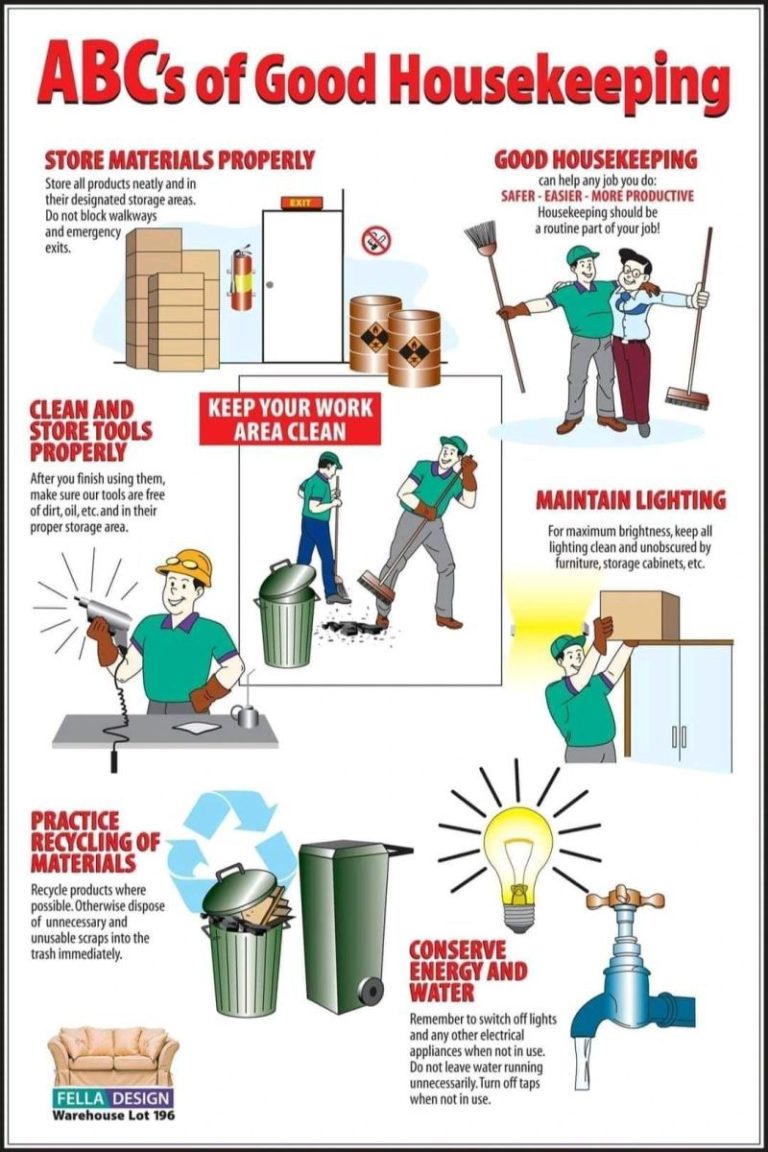Introduction
Housekeeping refers to the process of maintaining a clean, organized, and safe work environment. This includes keeping walkways clear, properly storing materials and tools, and disposing of waste correctly. Proper housekeeping isn’t just about tidiness, it’s about reducing hazards, improving morale, and increasing efficiency.
Why is Housekeeping Important?
- Safety: The number one reason for good housekeeping is to reduce accidents. A cluttered work area is a hazard. Materials left out can cause tripping, slipping, or falling. Spills or improperly stored chemicals can lead to burns or toxic exposure. A clean workspace is a safer workspace.
- Health: Clean environments reduce the risk of injury, illness, and other health hazards. Proper disposal of waste and chemicals prevents contamination and disease transmission.
- Efficiency and Productivity: A clean and organized workplace allows employees to find what they need quickly, reducing time spent looking for tools and materials. It reduces distractions and creates an environment conducive to focus and task completion.
- Morale: A clean and organized workplace fosters a sense of pride and professionalism. Employees are more likely to take care of their workspace and their colleagues’ work environment.
- Compliance: Many regulatory bodies, such as OSHA, require businesses to maintain safe and clean working conditions. Failure to comply can result in penalties and increased risk of injury.
Key Housekeeping Practices
-
Maintain Clear Walkways:
– Keep all aisles, hallways, and doorways free from obstructions.
– Ensure that emergency exits are easily accessible and not blocked by boxes, tools, or equipment.
– Remove debris or materials that could cause tripping hazards. -
Proper Storage of Tools and Materials:
– Store tools, equipment, and materials in designated locations when not in use.
– Label shelves, bins, and storage areas to make it easier for employees to store and retrieve items.
– Keep heavy items at waist height to prevent unnecessary bending or reaching. -
Waste Disposal:
– Always dispose of waste (scrap materials, paper, cardboard, food waste, etc.) in the correct bins.
– Avoid overfilling bins or leaving waste outside of containers. Empty bins when full.
– Separate hazardous waste (such as chemicals or broken glass) and dispose of it according to regulations. -
Clean Spills Immediately:
– Address spills promptly, whether they are liquids, oils, or other substances, to avoid slip hazards.
– Use appropriate cleaning materials (absorbent mats, towels, or rags) and follow company procedures for cleaning spills.
– For hazardous materials, ensure proper handling and dispose of the spill materials as per safety guidelines. -
Proper Lighting and Ventilation:
– Ensure that all areas are well-lit, especially walkways, stairways, and areas with heavy machinery.
– Regularly inspect light fixtures and replace any broken or burnt-out bulbs.
– Ventilate areas as required to avoid the buildup of fumes or gases, especially in confined spaces. -
Equipment Maintenance:
– Keep machines and tools in good working condition. Lubricate them regularly and ensure they are free of debris.
– Regularly inspect equipment for signs of wear and tear and report any issues.
– Ensure that machine guards and safety features are in place and functional. -
Personal Protective Equipment (PPE):
– Ensure that PPE is stored in a clean, accessible location.
– Employees should inspect their PPE before use and clean or replace it when necessary.
– Never leave PPE on the floor where it could be stepped on, damaged, or lost. -
Routine Cleaning:
– Assign daily, weekly, or monthly cleaning tasks (depending on the type of work) to keep all areas of the workplace clean.
– Clean work surfaces regularly to avoid the buildup of dust, dirt, or chemicals.
– Assign a “housekeeping champion” or create teams to ensure tasks are completed. -
Monitor and Audit:
– Regularly walk through the workspace to identify hazards and housekeeping issues.
– Conduct routine audits of cleanliness and organization.
– Take immediate action to correct any deficiencies or hazards found.
Best Practices for Encouraging Housekeeping:
- Training: Educate workers on the importance of housekeeping and provide training on how to keep their workspaces clean and safe.
- Set Expectations: Communicate that housekeeping is everyone’s responsibility. Establish clear guidelines and set the example by maintaining clean personal workspaces.
- Incentivize: Consider rewarding employees for maintaining cleanliness or creating a “cleanest workspace” competition.
- Inspection: Conduct regular housekeeping audits and inspections to ensure policies are being followed. Address issues immediately.
- Feedback: Encourage employees to report safety or cleanliness concerns. Provide a system where workers can report hazards related to poor housekeeping.
Conclusion:
Maintaining a clean and safe work environment is a shared responsibility. Good housekeeping prevents accidents, boosts efficiency, and promotes a healthy and productive workplace culture. Everyone, from the top management to the workers on the floor, has a role to play in maintaining a safe and organized environment. Let’s all commit to keeping our workplace clean and safe for everyone.



